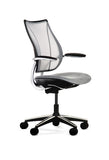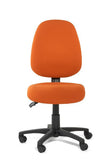Choosing the correct Ergonomic Chair
Care to compare? Check out our Comparison Chart: High Back Chairs
With so many chairs available, and many claiming to be 'ergonomic', it makes it difficult to choose what is best for you as people's body types and needs are vastly different. This guide will help you to understand the different functions, and how to choose a chair that is suitable for your needs:
Seat Pan
The seat pan (the part you sit on) is one of the most important parts as it helps support all the weight evenly. A good seat pan will have about 1-2 cm either side of the thighs so you are not sitting on the edge of the chair, and should allow a few fingers gap from behind the knees to the front of the chair. If the gap is too large, it will not support the thighs properly. If there is no gap then the seat pan can push into the back of your knees.
Most seat pans have a 'waterfall' edge so there are no firm edges digging into the legs.
Angle Adjustment: A forward or backward tilt to be able to adjust your posture during the day so your body is not conforming to one position for any length of time.
Seat Slide: Seat slides allow you to adjust the seat pan length to suit you. It is also good for chairs with multiple users as every user can adjust the seat better to suit.
Contoured Seat: Contoured seat pans have a raised lip around the outside of the seat pan and raised in the front, which helps you to sit into the chair and not on it. A contoured seat should not have a seat slide as this can be detrimental to the contours.
Dual Density/ Tri-Density Foam
Dual-density foam has two different types of foam in the seat pan, harder foam at the front to support the legs and a softer foam to support the buttocks. Tri-density foam uses a combination of soft, medium, and hard foams in the seat pan. Both dual-density and tri-density foams can vary in location from manufacturer to manufacturer.
Base, Castors & Chair Height
Look for a 5-star base which has been proven to be the safest and easiest to move around. Metal (aluminium) chair bases are stronger for heavier people (over 125 kg), but are mostly on chairs for aesthetics.
Most chairs have twin wheel plastic castors for movement. Some chairs have soft castor options which are ideal for timber or tiled floors. The plastic is softer to prevent scratching and scuffing floors, and the castors use more friction to stop the chair from sliding out from under you.
Task chairs have a gas lift to raise the chair height (typically 125-135 mm in height). You should be able to raise the height of the chair so the front of your knees are level (or slightly below level) with your thighs and your feet are firmly on the ground. Some chairs have a 80mm gas lift for smaller people or 200mm gas lift for taller people.
Armrests
Armrests can get in the way of sitting with a good posture, as they can stop you from getting close enough to the desk if they do not lower enough or be pushed out of the way. Most people will compensate by lowering their chair height, bringing their legs out of alignment with the floor, or not getting close enough to the desk, hence sacrificing good posture.
If considering armrests, make sure there is enough clearance for your desk, or the armrests can move out of the way or drop low enough to get under the desk. Look for armrests that are height adjustable, have wide pads for support, are comfortable, and have no sharp edges. Most armrests are only height adjustable, but a few chairs have 'advanced' armrests which can moved closer or further away from the chair, the arm pads can be moved forwards or backwards, or pivot into your body, and have gel surfaces for optimum comfort.
Armrests should not be used when typing unless they can be adjusted to be parallel to the work surface, and your arms are only lightly resting on them with no pressure.
Lumbar and Back Support
Lumbar support (the part that supports the lower back) is a major factor for good ergonomics. Most chairs have set lumbar support in the back that can be adjusted by chair back either higher or lower, or using the reclining feature. Some chairs have independent lumbar support adjustments; however you may find these chairs do not have any other adjustments available for the chair back.
When sitting make sure there is enough room for your hips, the lumbar support is sitting in the small of your back (where your spine curves inwards), and you are not being pushed too far forwards that there is no support for your thighs.
The back support should allow you to recline more than 90°, and be height adjustable to support the back. The chair back should be broad enough for your back, and be tapered so as to not push your shoulders forwards.
Mechanisms
The chair mechanism is the central hub of the chair. The mechanism allows for most functions like height adjustment, and seat pan and back tilt. Depending on the functions there will be 1-3 levers for adjustment. The best setup will have a 3-lever adjustment, and the levers will be positioned so you don't have to bend down too far to adjust the chair. Two other variants of the standard mechanism exist, Synchronised (Synchro) and Free-Float Mechanism.
Synchro mechanism: the seat pan and back can be tilted (rocked) freely backwards and forwards, in a synchronised function (both at the same time). The tilt mechanism can be locked in any position.
Free-Float Mechanism: The seat and backrest move independently of each other, following the movement of the body. The Free-Float can be locked in any position, allowing the greatest range of adjustment.
Headrest
Headrests can help support the head and neck when reading or talking on the phone. Check to make sure the headrest has adjustment options for higher or lower, and forwards and back.
Chair Covering
Chairs can be fitted with fabric, leather, suede, mesh, or a combination of these. If looking for a fabric cover, check the material used as synthetic fabrics (polyester) can be too warm in summer and too cold in winter, and not last as long. A natural fabric (wool) is preferable as it lasts longer, holds the colour better, is more comfortable, fire retardant, eco-friendly, and cooler in summer and warmer in winter. Most people go for a polyester fabric as it is generally included in the price of the chair and not as an optional extra, and you can usually get the chairs quicker.
Do not be deceived by cost-saving as the benefits of a natural fabric far outweigh the short term savings. Mesh is becoming popular in chairs with more companies introducing a mesh chair model to their line-up. Mesh can feel more comfortable as it hugs your body, but doesn't support your body as well as foam (especially multi-density foams). Most mesh chairs do not offer lumbar support as a standard, but may be purchased as an optional extra.
Remember lumbar support is essential for supporting your lower back. Because mesh chairs hug your body more than foam, they rarely have adjustable back height or an independent reclining function (most mesh chairs come standard with Synchro mechanisms). Mesh chairs breathe more as the mesh dissipates the heat from the body, and can be more comfortable in warmer climates, but has a reverse affect in colder climates as your body heat is removed, and a breezy environment (e.g. air-conditioning, open windows) can cause discomfort.
Warranties and Pricing
A good ergonomic chair should have a warranty of at least 5 years, with higher-end chairs having a warranty between 5 and 10 years.
Good ergonomic chairs can cost from a few hundred dollars to the thousands depending on the functionality and aesthetics of the chair. Manufacturers will spend hundreds of thousands of dollars and years in designing and testing their chairs. Some high-end chair manufacturers have spent around $1-2 million dollars and upwards of 6 years in designing their top end chairs.
Bear in mind that good ergonomic chairs will most likely last past their warranty periods, and will have the necessary adjustments as your needs change over the years with your age and work environment, and are better for multiple users. The first thing to look for is ergonomics and comfort to suit your needs. Aesthetics should play a secondary role.


